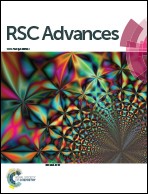Toward the design of bio-solar cells: high efficiency cascade energy transfer among four donor–acceptor dyes self-assembled in a highly ordered protein–DNA matrix†
Abstract
Artificial antenna complexes built via self-assembly are reported here, which indicated excellent energy transfer efficiency, macroscopic organization, unprecedented thermal stability, and ease of formation. Our system consists of four fluorescent donor–acceptor dyes, double-helical DNA and cationized bovine serum albumin, all self-assembled on cover glass slips to form functional materials. These captured radiation in the range of 330–590 nm, and excitation of any of the donor dyes resulted in efficient emission from the terminal acceptor. Excitation spectra provided unequivocal proof of energy transfer via jumper dyes, and transfer was interrupted when one of the jumper dyes was omitted, another direct evidence for cascade energy transfer. The entire assembly indicated unusually high thermal stability and continued to function efficiently even after exposure to 80 °C for >169 days, an important consideration for field applications. These unusually stable, high efficiency, multi-chromophoric, artificial antennas are the first of their kind to demonstrate self-assembled 4-dye energy cascade, converting blue photons to red photons.


 Please wait while we load your content...
Please wait while we load your content...